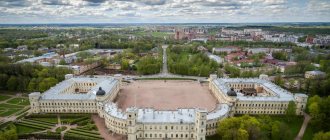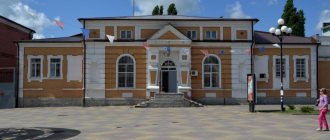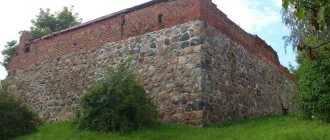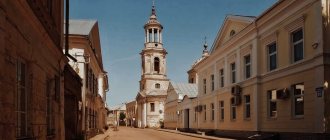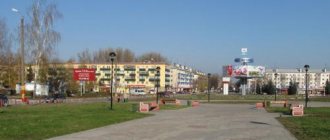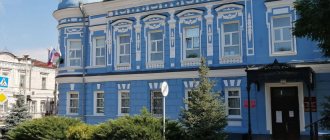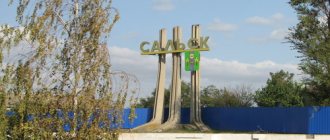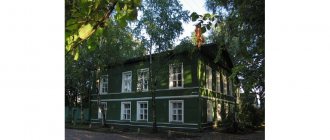Ivangorod
, a city in Russia, as part of the Kingisepp district of the Leningrad region, within the Kingisepp deanery of the Gatchina diocese. Located on the Prinarva Lowland, on the right high bank of the Narva River, opposite the Estonian city of Narva, with which it is connected by a bridge, 147 km west of St. Petersburg. Railway station on the St. Petersburg-Tallinn line. Population - 10.5 thousand people. (2018)
- On the map: Yandex.Map, Google map
The city was founded in 1492 by Moscow Grand Duke Ivan III Vasilyevich as a fortress named after the founder Ivangorod. These defensive fortifications were erected on the site of an ancient Russian settlement on Devichaya Gora opposite Narva. Also known from German documents of the century as “counter-Narva”.
After the Swedes attacked Ivangorod in 1496, the Moscow authorities began work to strengthen the fortress and further improve it. In the third quarter of the 16th century, Ivangorod already had three fortified areas and a suburb, surrounded by an independent wooden wall. As a result of construction carried out in several stages, Ivangorod turned into a technically advanced fortress that reliably protected the western borders of Russia from the invasion of the Livonian knights. The city grew quickly and was populated by servicemen and merchants. The governor's courtyard was also located here.
In 1558, the Livonian War began. From the Ivangorod fortress, the first Russian attack was launched on Livonian Narva. After the capture of Narva and further successful Russian military operations in Livonia, the Livonian Order collapsed, but almost all of its lands went to Poland and Sweden. As a result, Russia's war in the Baltic states turned into a war with Poland, Lithuania and Sweden.
In 1581, the Swedes captured Ivangorod, Narva, Koporye and Yam. Subsequently, Ivangorod several times during this war passed from Russia to Sweden and again returned to Russia, until in 1617, according to the Stolbovo Peace Treaty, which was very unfavorable for Russia, it was left among other cities and lands for Sweden. The occupation lasted for about a hundred years.
During the Northern War in 1704, Ivangorod was liberated by Russian troops.
In 1708, Peter I introduced a new administrative division of Russia, according to which the cities of the North-West, including Ivangorod, fell into the Ingermanland province, which in 1710 became known as St. Petersburg.
In 1719 he was assigned to the Narva province of the St. Petersburg province.
In the 19th century, one of the largest textile factories in Russia, the Krenholm Manufactory, was built near Ivanogorod on the Krenholm Peninsula.
Since November 1917, the territory of Ivangorod was part of Soviet Russia. In May 1919, Ivangorod and its surroundings were annexed to the territory of Estonia. In 1920, in accordance with the terms of the peace treaty concluded between Soviet Russia and Estonia, Ivangorod, as part of Narva, remained part of Estonia.
After Estonia joined the USSR in 1940, the city remained within the administrative borders of the newly formed Estonian SSR.
From 1941 to 1944 it was occupied by Nazi Germany
The establishment of the border between the Estonian SSR and the RSFSR along the Narova River (November 24, 1944), as a result of which Ivangorod and Narva ended up in different union republics, gave rise to the restoration of Ivangorod as an independent settlement.
In 1949, Ivangorod received the status of an urban-type settlement, and in 1954 - the status of a city.
Since January 1, 2006, Ivangorod has been part of the Kingisepp district as an urban settlement.
TOP-3 - what to see in Ivangorod in 1 day
The history of the emergence of an entire city on the steep slope of Narva is closely connected with the construction of the very first fortification on the western borders of the Russian land - the Ivangorod fortress. It was she who laid the foundation for Ivangorod.
Ivangorod Fortress
- Address: Pskovskaya street.
In 1492, by order of Tsar Ivan III, construction of the fortress began. They named it that way - Ivangorodskaya, in honor of the ruler. Maiden's Hill above the river seemed an ideal place for such a structure - it was protected on three sides by the river.
Only the bastion was built according to a clear plan, and its walls did not follow the terrain, as was always the case when building other forts. In plan it was a small quadrangle with four towers at the corners.
The small size of the fortress and its distance from the river contributed to the fact that it soon came under enemy attack and was captured after an assault that lasted only a few hours.
After this, it was decided to strengthen the fortress and significantly increase its territory. From the original fortification of the 15th century, only fragments now remain - mostly ruins, which are not impressive even in photographs.
Big Boyarshiy city
- Address: Ivangorod Fortress.
After a crushing enemy invasion in 1496, the fortress was restored and construction of a much larger one began on the eastern side. It was already a rectangle in shape. They called it the Big Boyar City.
We are talking about three completed walls and one common with the fortress of 1492. Four large round towers were built on the corners, and in the middle of the three walls there were square towers, dividing each of them into almost equal sections. There were gates in two towers - they reached us in a rebuilt form.
The upset Ivangorod was still not well enough fortified, since the building of 1492 remained in the very center of the Maiden Hill.
The space between the river and the fortress walls left the enemy the opportunity for a quick and easy assault. In this regard, already at the beginning of the 16th century, it was decided to enclose all available space on the shore with walls and towers. This is how the Castle appeared.
The walls were located directly above the fast flow of the river, which made it impossible to attack the bastion from this side. It turned out to be like a fortress within a fortress. However, the Swedes were able to capture it in the 16th century. and they managed to hold it for a long time. Only Peter the Great managed to recapture it during the Northern War.
Front City
- Address: Ivangorod Fortress.
At the very beginning of the 17th century. decided to expand Ivangorod - to the north of the Big Boyar City. The Front City was built, which they also tried to fortify well. Adjacent to it was the Boyarsky Val, filled with earth and later lined with stone.
As a result of the construction of this complex, the entire territory of Devichaya Gora was built up. Now there was almost no fear of enemy invasion.
The gradual construction of such a complex fortress ensemble lasted for a century. The small fortress turned into a complex structure that included several lines of defense. The entire complex was well preserved until the Great Patriotic War, when the fortress was at the western borders of the country and the Germans blew up many of the towers and destroyed some of the buildings.
Restoration is currently underway, but very slowly. Today, visitors can explore 11 towers, the place where the battery was once installed, as well as a hiding place, an arsenal, and a gunpowder warehouse. It is most convenient to inspect the object from the inside.
If you start your inspection from the Front Gate, you will immediately see two towers - the Long Neck and the Viceroy, and in front you can see Nabatnaya, from the Big Boyar City, which was a passage. The loopholes of the latter are similar in shape to the loopholes of the Kremlin in Veliky Novgorod.
In the XVI-XVII centuries. they were laid and now they can only be guessed by the slit-like openings. Three more towers are located on the eastern side of Boyarshiy Town. The central one was a travel pass. It was preserved only on plans. In the 16th century, a Diversion Tower in the form of an octagon was built in the middle of the spindle.
Now we can admire the corner towers in the western wall of the Big Boyarsky Courtyard - Proviantskaya and Vorotnaya. The latter began to be called that when a gate was built next to it in the form of a wide arched passage in the wall of the Front City.
The most interesting thing for tourists is the western wall of the Boyar City, which was originally conceived as a screen so that no one from the Narva Castle could see what was happening in the Boyar City. In this wall you can clearly see several layers of stone masonry from different times.
The main temples and churches of Ivangorod
Most of the churches in Ivangorod are associated with the fortress and are located on its territory. During the construction of the Boyar City, churches were erected in it, because a settlement without an Orthodox parish could not exist in those days.
Assumption Cathedral
- Address: Pskovskaya street.
Built in the 16th century. - during the next completion of the fortress. Constructed from white local limestone. The architecture is quite simple, but interesting - round towers with narrow windows and wide arched windows on the main gallery of the parish.
During the reign of the Swedes, the temple was Lutheran, but later Catherine returned it to Orthodoxy. The building was severely damaged after the Civil and Great Patriotic wars; many valuables were lost. Now the cathedral has been restored, and services have been held here again since 1994.
St. Nicholas Church
- Address: Pskovskaya street.
St. Nicholas Church and the Holy Assumption Cathedral are one church complex and are located nearby. The church is small, with one round dome. Construction took place after the Russian victory in the Livonian War and it is dedicated to Nikolai Ugodnik.
The Second World War caused damage to this shrine as well. The Orthodox landmark was closed for a long time and only at the end of the 20th century it began to be restored. Since 1991, she was able to open the doors to parishioners. Now it works.
Holy Trinity Church
- Address: Parkovaya street, 3.
The unusual church with a green roof in an eclectic style and Baroque elements was built between 1873 and 1875. by order of Baron Stieglitz and with his money. At that time, this was caused by the death of his wife, but in the future he planned to build a tomb here for his family.
His plans came true - the baron, his wife and daughter rested in the church, but after 1917 it was abandoned. It met with desolation during the war and was partially destroyed. At one time it was used as a warehouse, but for most of the second half of the 20th century the church was empty.
More recently, the Mariinsky Theater took it under its guardianship, restoration work began, which is still ongoing, but the church is already operating and welcoming parishioners. It is the center of the spiritual life of Ivangorod. And its lower part remained the Stieglitz tomb.
Church of Peter and Paul
- Address: City Cemetery.
This temple is located at the City Cemetery. The ancient building, which was originally erected as a chapel, was rebuilt into a small church. It became the tomb of the Orlov family, a famous Narva merchant.
Time and wars have not been kind to this parish. Now very dilapidated and sad, it is in disrepair, the tomb has been plundered. It does not work.
Chapel on Kamperholm Island
- Coordinates on the map: 59.406882, 28.177430.
Previously, this was the island of Kamperholm, but now the river has become shallow, overgrown, and the island as such does not exist. Here in 1996 a memorial cross was erected to the fallen soldiers during the Northern War, and here in 2006 a modest wooden chapel was founded.
The cross and the chapel formed a single ensemble, extolling the Russian Orthodox army. Here you can take a break from the bustle of the city and listen to the surrounding nature in silence. Photos are often taken against the background of this landmark of Ivangorod.
Ivangorod: beautiful architecture of the city
Ivangorod is a very small city, but it has very interesting and unusual areas, where architecture from different periods coexists today and looks colorful.
Krenholm manufactory
- Address: st. Tekstilshchikov, 2, Parusinka village.
A lot of crumbling brick buildings are all that remains of the once largest manufactory, where over 10,000 people worked. The production of canvas fabrics belonged to Baron Stieglitz. A city, an industrial area, was built around the factory; there was a hospital, a school, a nursery, houses for workers and management, and a park.
It was a modern production facility at that time - 8 thousand spinning machines, which worked thanks to water passing through turbines and special channels. The factory had an automatic fire extinguishing system that was innovative at that time - water sprayed if the temperature exceeded certain values.
Baron Stieglitz cared not only about production, sales and profit, but also about the well-being of workers. Despite rather strict requirements, fines and even outbreaks of rallies and strikes, good working conditions were created for people. The infrastructure was developed: a hospital, school, kindergarten, bathhouse and laundry were built. The workers used the latter for free.
Today, practically the ruins of the factory can be seen by walking around or walking through the Parusinka district. It can be dangerous to go inside - the buildings are collapsing.
Urban district Parusinka
- Coordinates: 59.359374, 28.205708.
In the 19th century, Baron Stieglitz built a canvas factory on the outskirts of Ivangorod, around which workers' houses and barracks began to be built. The quarter was very reminiscent of factory towns in England. Initially it was called Krenholm, the manufactory was also Krenholm.
After the collapse of the USSR and the separation of Estonia, this quarter was divided by the border into two parts: the Estonian part remained Krenholm, and the Russian part was named Parusinka, which reflects the type of activity of the factory that existed here in the late 19th – early 20th centuries.
The architecture of this area turned out to be original and atypical. Now all the barracks are residential buildings. They are adjacent to the building of the manufactory itself, a former workers' canteen, houses from the Stalin era, built later, and Estonian houses.
The mixture of styles, architecture, and purpose of buildings leaves an indelible impression. The quarter seems old, unkempt, the buildings are falling apart - a kind of industrial reserve, but tourists come to see it, because everything unusual always attracts.
Gas holder
- Address: Tekstilshchikov Street.
A large round gas holder is located in Parusinka. It was built for the needs of the factory - a supply of gaseous substances was always stored in gas tanks, but was also used as a canteen for workers. The rather beautiful brick building is now falling apart. You shouldn’t go inside: this landmark of Ivangorod is in poor condition!
Bridge "Friendship"
- Address: 59.376657, 28.204164.
The automobile and pedestrian bridge across Narva between Estonia and Russia has been called “Friendship” since the existence of the USSR. It was built in 1960 and reconstructed in 2010. The railway bridge is also interesting here: when a long freight train passes over it, its head ends up in one country, but its tail remains in another.
Narvskaya HPP
- Address: st. Mayakovsky, 5.
In the middle of the 20th century, not far from the Narva Falls, the Narva Hydroelectric Power Station was built. The dam ended up on the territory of two countries after the collapse of the USSR, but belongs to Russia.
Due to the border territory, the object is restricted and visiting is prohibited, but you can always observe the discharge of water from the towers of the fortress. The hydroelectric power station provides energy to the entire Ivangorod and nearby settlements.
References
Notes
- ^ a b c d f f
Region Law No. 32-ounce - ^ a b c Encyclopedia of Russian Cities
. Moscow: Great Russian Encyclopedia. 2003. p. 150. ISBN 5-7107-7399-9. - ^ a b
“Archival copy” Kingisepp district (August 1927) (in Russian). System of classifiers of executive bodies of state power of St. Petersburg. Archived from the original on December 11, 2013. Retrieved February 28, 2014.CS1 maint: archived copy as title (site link) - ^ a b
Federal State Statistics Service of Russia (2011).
“All-Russian Population Census 2010. Volume 1" [All-Russian Population Census 2010, vol. 1]. All-Russian Population Census 2010 [All-Russian Population Census 2010]
(in Russian). Federal State Statistics Service. - "26. The size of the permanent population of the Russian Federation by municipalities as of January 1, 2022.” Federal State Statistics Service. Retrieved January 23, 2022.
- ^ a b c d
Law No. 81-oz. - "On the calculation of time." Official Internet portal of legal information
(in Russian). June 3, 2011. Retrieved January 19, 2022. - Post office. Information and computing center of OASU RPO. ( Post office
).
Search for postal facilities ( Search for postal facilities
) (in Russian) - General information about Ivangorod (in Russian). Official website of Ivangorod. Retrieved February 28, 2014.
- Federal State Statistics Service of Russia (May 21, 2004). “The population of Russia, the constituent entities of the Russian Federation as part of federal districts, urban settlements, urban settlements, settlements, settlements is 3 thousand or more people” [Population of Russia, its federal districts, constituent entities of the federation, districts, urban settlements, rural settlements - administrative centers, rural settlements with a population of more than 3000 people] (XLS). All-Russian Population Census of 2002 [All-Russian Population Census of 2002]
(in Russian). - “All-Union Population Census of 1989. The actual population of the union and autonomous republics, autonomous regions and districts, territories, regions, urban settlements and villages. Milleks meile idapiir ja ilma lepinguta?” Eesti Päevaleht
(in Estonian). Archived from the original on October 9, 2007. Retrieved September 27, 2009. - "Enn Eesmaa: väide Petseri-soovist on ennekõike provokatiivne." Eesti Päevaleht
. Archived from the original on August 26, 2009. Retrieved September 27, 2009. - Order of the FSB of the Russian Federation dated June 2, 2006 No. 239 “On the border zone on the territory of the Leningrad Region”; Order of the FSB of the Russian Federation dated May 5, 2007 No. 222 “On amendments to the Order of the FSB of the Russian Federation dated June 2, 2006 No. 239” On the limits of the border zone on the territory of the Leningrad Region “”. Russian newspaper
(in Russian).
2006
. - Commercial organizations of the city (in Russian). Official website of Ivangorod. Retrieved April 7, 2013.
- Monuments of history and culture of the peoples of the Russian Federation (in Russian). Ministry of Culture of Russia. Retrieved June 2, 2016.
- Historical, Architectural and Art Museum “Ivangorod Fortress” (in Russian). Russian Network of Cultural Heritage. Retrieved March 26, 2013.
Sources
- Legislative Assembly of the Leningrad Region. Regional Law No. 32-oz of June 15, 2010 “On the administrative-territorial structure of the Leningrad region and the procedure for changing it,” as amended. Regional Law No. 23-oz dated May 8, 2014 “On the merger of municipalities” Primorskoye urban settlement of the Vyborg district of the Leningrad region and Glebychevskoye rural settlement of the Vyborg district of the Leningrad region and on amendments to certain Regional laws. Came into force on the date of official publication. Published: “Vesti”, No. 112, June 23, 2010 (Legislative Assembly of the Leningrad Region. Regional Law No. 32-oz dated June 15, 2010 On the administrative-territorial structure of the Leningrad Region and the procedure for changing it
As amended by the Regional Law dated 05.08. 2014 No. 23-oz.
On the annexation of the municipalities “Primorskoye Urban Settlement” of the Vyborg District of the Leningrad Region and the “Glebychevskoye Rural Settlement” of the Vyborg District of the Leningrad Region and amendments to various regional laws.
Effective from the date of official publication.). - Legislative Assembly of the Leningrad Region. Regional Law No. 81-oz of October 28, 2004 “On establishing boundaries and granting the status of an official municipal formation to the Kingisepp Municipal District and the municipalities within it,” as amended. Regional Law No. 17-oz dated May 6, 2010 “On amendments to some regional laws in connection with the adoption of the federal law “On amendments to certain legislative acts of the Russian Federation in connection with improving the organization of local self-government””. Came into force 10 days from the date of official publication (November 29, 2004). Published: “Bulletin of the Government of the Leningrad Region”, No. 34, November 19, 2004 (Legislative Assembly of the Leningrad Region. Regional Law of October 28, 2004 No. 81-oz. On establishing boundaries and giving the appropriate status to the municipal formation Kingiseppsky Municipal District and its constituent municipalities in its composition
As amended by Regional Law No. 17-oz dated 05/06/2010
On amendments to various regional laws in connection with the adoption of the Federal Law “On amendments to various legislative acts of the Russian Federation in connection with the improvement of the organization of local self-government”
. Valid after 10 days from the date of official publication (November 29, 2004).
Ivangorod museums and exhibition centers
Ivangorod cannot boast of theaters that remain on the Narva side, but several very interesting museums and monuments always attract tourists.
Museum of the city of Ivangorod
- Address: Kingiseppskoye sh., 8.
The Narva merchant Panteleev built a two-story house in the mid-19th century, which now houses the Ivangorod Museum and an art gallery.
The building was amazingly preserved after the Second World War. The founding date of the Ivangorod Museum is May 30, 1980. For 40 years now, it has been telling and showing pages of history, revealing the stages of construction of the fortress, formation and maturity of the town.
The main exhibition presents household items of citizens of different eras, documentary sources and artifacts from archaeological excavations.
Museum of Military Defense Architecture of North-West Rus'
- Address: Kingiseppskoye sh., 6/1.
The Museum of Fortresses is located in the royal customs building near the Ivangorod fortress. The bright red building belonged to the merchant Orlov, who lived here in the 19th century and donated considerable funds for the development of Narva, the hydraulic system of Valaam Island and other objects. The exhibition opened here in 1984.
The museum complex is called so because here you can see wooden models of eight fortresses built in these parts of Rus' at different times. In addition to the models, visitors will be told and shown secret details of the Livonian and Northern War, significant events of which took place near Ivangorod.
The museum attraction contains a rich exposition of ancient objects found in excavations of fortresses of the 14th-19th centuries, documents, books and manuscripts, which contain a lot of information about the process of building a particular fortification. Recently, the museum has been providing the opportunity to watch a virtual tour of the Ivangorod Fortress.
Art gallery
- Address: Kingiseppskoye sh., 8.
The art gallery introduces tourists and local residents to the work of artists from the World of Art association, which was formed at the beginning of the 20th century.
Here it is easy to see the works of the artist and master of porcelain painting A. Shchekotikhina-Pototskaya, her husband I. Bilibin and her son M. Pototsky. Most of the exhibition is devoted to the latter.
In addition to paintings, the gallery presents objects of applied art and objects that are related to the life of artists.
Ticket prices and opening hours
A visit to the Ivangorod Fortress is possible from 10:00 to 18:00, seven days a week, the rest of the museum has a day off on Monday, and at the Art Museum every last Thursday of the month is a sanitary day.
Tickets can be purchased at the box office until 17:30. Children under 16 years of age can enter for free; for other visitors, ticket prices to the Ivangorod Fortress in 2022 on the official website (without excursion) are as follows:
- entrance - 130 ₽ (adults)/65 ₽ (students, pensioners);
- Small powder granary plus entrance - 250 ₽/125 ₽;
- Art Museum - 100 ₽/50 ₽;
- Museum of Fortresses - 50 ₽/25 ₽.
Restorers continue to work in the Ivangorod Museum: in 2022 they will restore the Great Powder Granary, the official website of the Ivangorod Fortress will announce the opening of a new exhibition there. In winter, you can visit temples and museum exhibitions on the territory, and in the warm season - historical reconstructions and music festivals.
City monuments and memorials in Ivangorod
Ivangorod is not without a lot of interesting landmarks, monuments and sculptures, where you can also take remarkable selfies or photographs.
Monument to “Panteleevsky” brick
- Address: Kingisepp highway.
Near the Ivangorod Museum and the house of the merchant Panteleev there is a unique monument to bricks produced at the Panteleev manufactory. A brick with the FYAP mark (“Philip Yakovlevich Panteleev”) is embedded in a pedestal of stones. It is a symbol of the city.
Monument "Girl Spinner"
- Address: Tekstilshchikov Street.
This monument is preserved at the entrance to the canvas factory. The plaster statue now spins its linen thread here all the time. Unfortunately, the sculpture is deteriorating and collapsing.
Memorial War Cemetery
- Coordinates: 59.376427, 28.230802.
In the southern part of Ivangorod there are three mass graves of Soviet soldiers who gave their lives in the Great Patriotic War. In total, 1893 soldiers are buried in the burial place. It is an integral part of the Ivangorod memorial.
The memorial includes graves of different times - these are soldiers who served and died in Chechnya, and the remains of WWII soldiers found in this area, including unknown soldiers, there is a memorial sign “In memory of former prisoners of fascist concentration camps.”
Captain Yuri Viktorovich Pastorov, Hero of the Soviet Union, fought and died for the liberation of Ivangorod. A street in the city is named after him, and there is a memorial plaque on the wall of the house. He is also buried in the Memorial War Cemetery.
Stele "In Memory of Former Prisoners of Nazi Concentration Camps"
- Address: Memorial military cemetery.
The monument was erected at the memorial military cemetery in 1965. It is a small black stele with the inscription: “1941-1945. In memory of former prisoners of fascist concentration camps."
On topic: Sights of the Leningrad region
Nature of Ivangorod and its surroundings
In the vicinity of the city you can find many interesting places where you can go fishing, pick mushrooms, relax, indulging in complete unity with Mother Nature.
River Narva
- GPS coordinates: 59.375357, 28.203428.
Among other natural attractions, the main place in Ivangorod is occupied by the Narva River. It always played a big role in his life: it was founded on its banks, its riverbed divided the city into two settlements and two countries, it saw a lot and shows a lot to its descendants.
The river flows from Lake Peipsi and flows into the Narva Bay of the Gulf of Finland. It is quite small in length - only 77 km. Excellent fishing awaits fishermen in Narva. In its lower reaches, salmon, eel and lamprey come to spawn. The middle reaches are flooded by the Narva Reservoir, which was created during the construction of the dam to ensure the operation of the Narva Hydroelectric Power Station. The upper course is calm, without any features.
Within Ivangorod, the river flows in a narrow canyon up to 20 m deep. This relief form is a landscape reserve and is protected by the state. The Narva waterfall is the most powerful in this part of Europe, its height is 7 m. The poet P. Vyazemsky wrote about the Narva waterfalls and rapids in his poems.
Narva waterfall
- Coordinates on the map: 59.357441, 28.201341.
The Narva River used to be fast and impetuous and created two waterfalls in the soft limestone rock. In size they surpassed all other cascades that were in this part of Europe.
The canvas manufactory of Baron Stieglitz was very conveniently located next to the Narva Falls: they were used to supply energy to production.
In the middle of the 20th century, the Narva Hydroelectric Power Station was built, after which one of the waterfalls dried up and disappeared. The full power of what remains can be felt and seen only during the spillway at the waterworks.
Narva Reservoir
- Coordinates: 59.290782, 28.179647.
The middle reaches of the Narva are flooded by the Narva Reservoir, which, like the river, is located on the border of Estonia and Russia. An artificial reservoir was created during the construction of a dam in the southern part of the lake to ensure the operation of the Narva hydroelectric power station and retaining structures.
All structures were founded in 1950-1955. As with the creation of other artificial reservoirs, the construction of the Narv reservoir was not without sad consequences - more than 4 thousand hectares of agricultural land, villages and towns were flooded, 742 houses had to be relocated.
Before the flooding, there were many swamps here, so now a large amount of peat is hidden under water and along the banks of the reservoir. Several small islands float on the surface of the artificial lake. The depths are sufficient for good fishing. Many tourists and locals love to relax here.
Don't miss: Sights of St. Petersburg
Narva waterfall
Narva Waterfall is the largest in this part of Europe. It is of natural origin.
Originally there were two waterfalls. They provided energy to the canvas factory. But after the construction of the Narva State District Power Plant, there was only one left, and it can be seen only once a week, more often on Friday, when water is released at the hydroelectric complex.
Huge masses of water roar down from the stone ledges. When there is no fault, the river bed and protruding rocks are visible.
Where to go in Ivangorod with children
Of course, in Ivangorod there is entertainment for children, although there are not many of them, and mostly these are just beautiful places within the city limits that everyone, both the child and his parents and grandparents, can admire.
Ivangorodsky promenade
- Address: Naberezhnaya street.
As part of the River Promenades project, supported by both the Russian and Estonian sides, promenades were organized on the opposite banks of Narva. True, in Narva it stretched for a kilometer and became a favorite vacation spot for the townspeople, but in Ivangorod it did not even reach 200 m.
Thus, in 2014, cooperation between two cities and two countries laid the foundation for another cultural site in Ivangorod, which, hopefully, on the Russian side will be fully implemented during the third stage of improvement. However, even now it will be interesting for families with children to take a walk here.
Stieglitz Manor and Park
- Coordinates: 59.351391, 28.196116.
Baron Stieglitz built an estate not far from his enterprise. The house was wooden, in neo-Russian style. Now you can find only a few steps - that’s all that remains of the estate.
At the same time, a park was planted where Empress Maria Feodorovna herself walked; in 1890, Emperors Alexander III and Wilhelm II met. In honor of this significant event, the baron planted a memorial oak tree in front of the estate. The tree can still be found today, although the park area is quite large - 15 hectares, which were carefully planted and maintained according to all the rules of landscape gardening art of the 19th century.
Here, on the outskirts of the park, Baron Stieglitz built the Church of the Holy Trinity, where the remains of himself and his wife and daughter are still buried. The reviews highlight many positive aspects of the park as a place for a walk with a child.
Ivangorod House of Culture
- Address: st. Yuri Gagarina, 6A.
This place is located in the center of Ivangorod, not far from the Bus Station, the City Administration building, the Central Sports Complex and the Vityaz Hotel. Reviews call the local recreation center very cozy, albeit small, with attentive management and staff. Here you and your child will be able to watch performances by local creative groups, attend events of Ivangorod enterprises and industries, children's clubs and sects.
Read reviews of attractions in other cities of the Leningrad region:
- Shlisselburg, Sosnovy Bor, Vyritsa, Tosno,
- Gatchina, Strelna, Novaya Ladoga, Tikhvin,
- Vasilyevsky Island, Tsarskoe Selo, Vsevolozhsk,
- Primorsk, Lodeynoye Pole, Sestroretsk, Krasnoye Selo,
- Kingisepp, Lomonosov, Luga, Kronstadt and Vyborg.
As you can see, the sights of Ivangorod are mostly connected with its history. A walk through them will help you understand how a fairly large modern city with diverse spheres of life could grow from a small quadrangular fortress.
How to get there
The most convenient way to get to Ivangorod from St. Petersburg is by electric train or regular bus, which departs from the city bus station several times a day.
In addition, Ivangorod has a railway connection with Moscow - a train departs from the Leningradsky station to Tallinn. Ivangorod is part of the border zone, and since 1993 free entry there has been closed. You can enter the territory of the fortress only with special passes, which are issued in advance at the Border Department of the FSB of Russia for St. Petersburg and the Leningrad Region. The procedure is simple, but not particularly fast: the pass takes up to 10 working days. There is also the option of purchasing a pass through any travel agency - there are inexpensive one-day tours to the fortress.
Without a pass, you can travel to the border area if you have a valid Schengen visa, but in this case a number of restrictions will apply: you can only drive along the Tallinn Highway, and it is forbidden to leave your vehicle, except in emergency situations.
Details about the rules of entry into Ivangorod are described on the city’s official website.
Travelers claim that in practice passes are rarely checked, but there is always a chance of encountering border guards.



